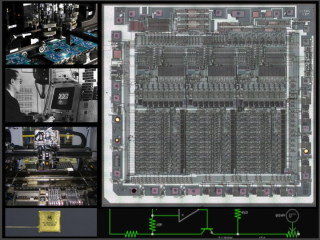 Dr. Kyle Stine, 2014-2015 Media@McGill Postdoctoral Fellow, will give a talk on his research, "Circuits of Reproduction: Toward an Archaeology of Machine Perception," Thursday, February 12, 2015 at 5:30 p.m.
Dr. Kyle Stine, 2014-2015 Media@McGill Postdoctoral Fellow, will give a talk on his research, "Circuits of Reproduction: Toward an Archaeology of Machine Perception," Thursday, February 12, 2015 at 5:30 p.m.
Media@McGill is co-sponsoring this talk with the AHCS Speaker Series; it will be held in Arts W-215, Faculty of Arts, McGill University, 853 Sherbrooke West, Montreal, QC.
Free and open to the public.
Abstract:
Computing and imaging face one another from two sides of a challenge. Every eighteen months, per Moore’s Law, the number of transistors on a square inch of silicon doubles. The first transistor fabricated at Bell Labs in 1947 filled nearly this entire square inch on a wafer of germanium, with the connections being placed by hand. Until the late 1960s, integrated circuit design was still accomplished manually in what an early designer has called “a back-breaking process.” Using a layer of red plastic film called rubylith, a worker would carefully cut out the design by hand, photograph it with a large reduction factor, and then photograph it again to achieve the desired level of miniaturization to create a mask. But by the 1970s, all of these hand operations—designing, cutting, and photographing—had been automated by computers, and soon circuit size and complexity were so great as to make fabrication impossible without automation working at microscopic scales. Throughout this process, each time a piece of handwork was eliminated, part of it was outsourced to imaging. However, this only created a different problem. As pixel sizes decreased, the processing power necessary to design, simulate, and inspect integrated circuits increased, requiring further miniaturization in circuit design. This constant call for adjustment between image resolution and computing power encapsulates in miniature the series of epochal adjustments between media systems, and it forms the guiding idea of my talk. Tracing a visual history of computation, my talk focuses on the integrated circuit as a figure for understanding how computational and imaging technologies fold into one another and increasingly eliminate the need for human intervention, forming a circuit of machine perception.
Bio:
Kyle Stine is the 2014-2015 Media@McGill Postdoctoral Fellow working within the 2014–2015 theme of Media, Senses, and Sensibilities. He received a PhD in Film Studies from the University of Iowa, specializing in media theory and sound studies within the broader purview of the history and philosophy of technology. His research centres on the interface between culture and technology.
His current book project develops a media archaeology of machine perception, drawing on the histories of cinema, sound media, and phenomenology, together with the engineering fields of machine vision, pattern recognition, and artificial intelligence. Tracking down research leads has led him to the MIT Institute Archives and Special Collections, the MIT Museum, the Kodak Historical Collection, and the Library of Congress. The project has also been supported by a Mellon/ACLS Dissertation Completion Fellowship and a residency at Iowa’s Obermann Center for Advanced Studies.